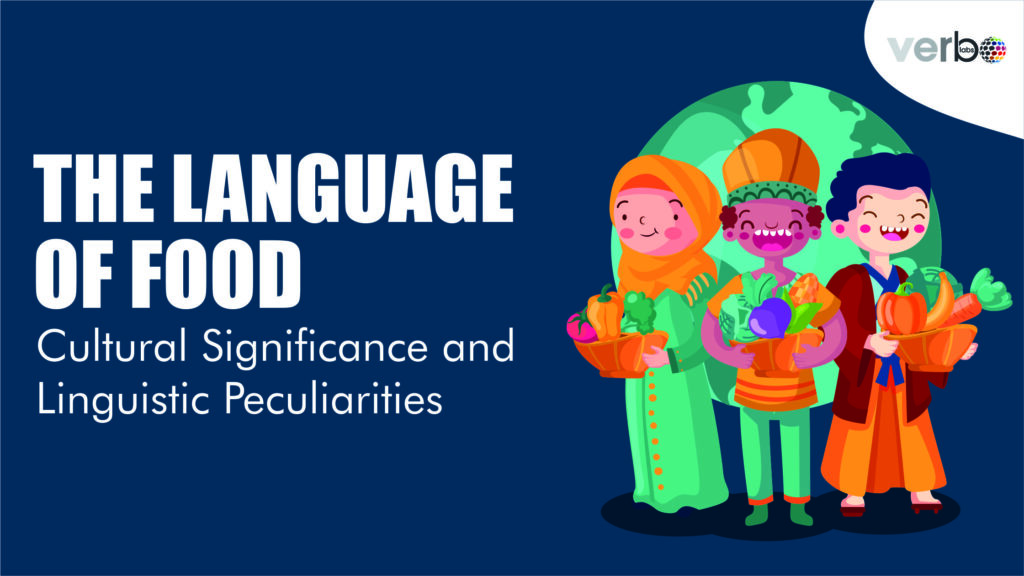Food is not only a source of sustenance but also a powerful expression of culture. It carries many meanings, traditions, and stories that connect people to their roots. In this blog, we will explore the fascinating relationship between food, culture, and language. We will delve into the cultural significance of food and the linguistic peculiarities that surround it, uncovering the richness and diversity that food brings to our lives.
Food is deeply intertwined with a community’s identity, reflecting its history, geography, climate, and values. Each culture has unique culinary traditions that have been passed down through generations. Exploring the culinary heritage of different cultures through professional translation services can provide valuable insights into their customs, beliefs, and social structures.
Historical and Cultural Influences on Food Language
- Evolution of food terminology
Food terminology has evolved through various historical and cultural influences, changing the landscape of professional translation services. One significant aspect is the borrowing of words from other languages. As cultures interacted and exchanged goods and ideas, they also adopted and adapted culinary terms.
For example, English has borrowed numerous food-related words from French, such as ‘cuisine,’ ‘sauté,’ and ‘croissant.’ Similarly, Italian words like ‘pizza’ and ‘spaghetti’ have become commonplace in many languages. These borrowings not only enriched the vocabulary but also reflected the cultural connections and influences between different regions. Globalization and increased international trade have facilitated the spread of culinary concepts and the incorporation of foreign terms into local languages and app translation service for food.
- Cultural significance of food-related idioms and expressions
Food-related idioms and expressions play a significant role in language, often employing metaphors and symbolism. Food is used metaphorically to express emotions, experiences, and concepts. For example, phrases like “spill the beans,” “piece of cake,” or “bitter pill to swallow” use food-related terms to convey non-literal meanings.
Regional and Geographical Variations
- Dialects and accents in food language
Regional dialects and accents influence language, and this is particularly evident in the language of food. Pronunciation, intonation, and vocabulary can vary significantly across different regions, resulting in distinct regional accents and dialects in food language. For example, the pronunciation of certain food items like ‘tomato’ or ‘herbs’ can vary between British English and American English, playing a vital role in professional translation services.
- Regional food names and vocabulary
Regional variations in food language extend beyond accents to encompass the names and vocabulary used to describe ingredients and dishes. Different regions often have their unique names for the same food item. Moreover, regional variations can be observed in the naming of specific dishes and ingredients. Certain words may have different names in different regions, reflecting local culinary traditions and preferences. For example, a bread-based dish topped with tomato sauce and cheese is called ‘pizza’ in Italy, but in France, it is known as ‘tarte flambée’ or ‘flammekueche.’ Similarly, the terminology used in recipes can vary regionally, with different terms used for cooking techniques, measurements, and ingredients.
Technical and Professional Jargon
- Culinary terminology and vocabulary
The language of food encompasses a vast array of technical and professional jargon specific to the culinary world. This specialized terminology serves to differentiate between various cooking techniques and methods. For example, terms like ‘braising,’ ‘sautéing,’ and ‘grilling’ indicate specific ways of preparing food, each with its own set of principles and desired outcomes. Additionally, the pastry, baking, and beverage industries have their specialized vocabulary.
Pastry chefs use terms like ‘pâte feuilletée’ (puff pastry) and ‘ganache’ (a mixture of chocolate and cream), while bakers might refer to techniques such as ‘proofing’ and ‘scoring.’ Similarly, the beverage industry utilizes terminology related to wine tasting, brewing methods, and mixology, such as ‘tannins,’ ‘dry hopping,’ or ‘muddling.’
- Jargon in professional kitchens and restaurants
Professional kitchens and restaurants have unique jargon and slang that are used among chefs and kitchen staff. This insider language helps to streamline communication and foster efficiency in fast-paced culinary environments. Chefs and kitchen staff might use code words to communicate orders or refer to specific ingredients or equipment. For example, they may use terms like ‘86’ to indicate that a particular dish is no longer available or ‘behind’ to communicate their movements in a crowded kitchen.
In addition to kitchen jargon, specialized terminology is used in the front-of-house operations for service and customer interactions. Restaurant staff may use terms like ‘mise en place’ (preparation and organization before service) or ‘comp’ (to provide a complimentary dish or drink) to ensure smooth service and enhance the customer experience.
Influences of Marketing and Media
- Language techniques in food advertising
Food advertising utilizes various language techniques to capture consumers’ attention and influence their purchasing decisions. Persuasive language and emotional appeals are commonly employed to create a desire for certain food products.
Advertisements and app translation services often use words like ‘delicious,’ ‘tempting,’ or ‘’mouthwatering’ to evoke positive emotions and entice consumers. Descriptive language also creates sensory appeal, with vivid descriptions of flavors, textures, and aromas. Phrases like “crispy golden crust,” “rich and creamy,” or “bursting with flavor” are used to stimulate the senses and enhance the perceived quality of the food product.
- Food-related language in popular media
Popular media, such as cooking shows and celebrity chefs, significantly impact food language. Cooking shows not only introduce viewers to new recipes and cooking techniques but also influence how they talk about food. Celebrity chefs often introduce and popularize culinary terms, creating a shared food language among enthusiasts. Additionally, the rise of food blogging, social media, and hashtag trends has further shaped food-related language. Food bloggers and social media influencers introduce new food vocabulary, share food experiences, and create food-related hashtags that reflect current culinary trends and preferences.
Etiquette and Politeness in Food Language
- Verbal and non-verbal communication in dining situations
Effective communication in dining situations involves both verbal and non-verbal cues. Verbal communication includes expressing preferences, ordering food, and conversing about the meal. Non-verbal communication encompasses body language, gestures, and facial expressions, which can convey appreciation, enjoyment, or dissatisfaction with the food. These non-verbal cues are crucial in enhancing the overall dining experience and creating a positive atmosphere.
- Politeness strategies and expressions related to food
Politeness is highly valued in food language and is essential for maintaining harmonious social interactions during meals. Politeness strategies include using polite forms of speech, such as “please” and “thank you,” when interacting with servers or hosts. Expressing gratitude and compliments for the food and hospitality is customary in many cultures, acknowledging the effort and skill involved in preparing the meal. Additionally, navigating dietary restrictions and preferences with tact and consideration is crucial. Politeness in these situations involves communicating needs or limitations, expressing gratitude for accommodations, and avoiding criticism of the food or choices made by others.
Gender and Food Language
- Gendered language in culinary professions
Culinary professions have often been associated with gendered language and stereotypes. Specific culinary terminology and job titles have traditionally been assigned gendered connotations. For example, terms like ‘chef’ and ‘cook’ have often been associated with masculinity, while words like ‘pastry chef’ or ‘baker’ have been more associated with femininity. These gender biases in culinary terminology can perpetuate stereotypes and limit opportunities for individuals in the profession. However, efforts are being made to promote inclusivity and diversity by challenging these stereotypes and promoting gender-neutral language in culinary settings.
- Gendered associations with specific foods and eating behaviors
Certain foods and eating behaviors have been culturally associated with gender. For example, meat-heavy dishes are often associated with masculinity, while salads or light meals are often associated with femininity. Gendered metaphors and expressions related to food, such as “strong as a steak” or “sweet as sugar,” further reinforce these associations. Cultural and historical factors play a role in shaping these gendered food associations, reflecting societal norms, expectations, and divisions of labor.
The Future of Food Language
- Technological advancements and their impact on food language
Technological advancements are shaping the future of food language in various ways. AI-driven recipe generators and smart kitchen devices are revolutionizing how people access and create recipes. These advancements can have linguistic consequences as AI-generated recipes may introduce new terminology or innovative cooking techniques. Additionally, language-based food recommendations and personalized menus are becoming more prevalent, using algorithms to analyze individual preferences and dietary needs. This customized approach to food selection and menu creation can result in new language patterns and terminology tailored to individuals’ tastes and nutritional requirements.
- Changing food trends and their linguistic consequences
Changing food trends are likely to influence food language in the future. Sustainable food practices, such as plant-based diets and zero-waste cooking, are gaining popularity, and their language representation is evolving. New terms and expressions related to sustainability and ethical food choices are emerging, reflecting the shift towards environmentally conscious consumption. Similarly, health and wellness movements are impacting food language, with terms like ‘superfoods,’ ‘clean eating,’ and ‘mindful eating’ becoming more prevalent. These movements introduce new language patterns and expressions highlighting the connection between food, health, and well-being.
Conclusion
Food language is vital in cultural, social, and professional contexts. It not only reflects the diverse culinary traditions and practices but also serves as a means of communication, identity, and expression. Food language enables individuals to navigate culinary experiences, express appreciation, communicate dietary needs, and engage in meaningful conversations about food. In professional contexts, understanding culinary terminology, doing Hindi dubbing, and using jargon is essential for effective communication and expertise in the culinary field.
The language of food encompasses a fascinating array of linguistic peculiarities that reflect cultural, historical, and social influences. Getting a language translation service provider onboard allows us to appreciate food and the emotions attached while enhancing our culinary experiences. The field of food language holds immense potential for further research, exploration, and innovation, offering exciting avenues for linguistic and cultural analysis in the future. Verbolabs provides certified translation services to foster cultural understanding and contributes to the broader study of language and culture



